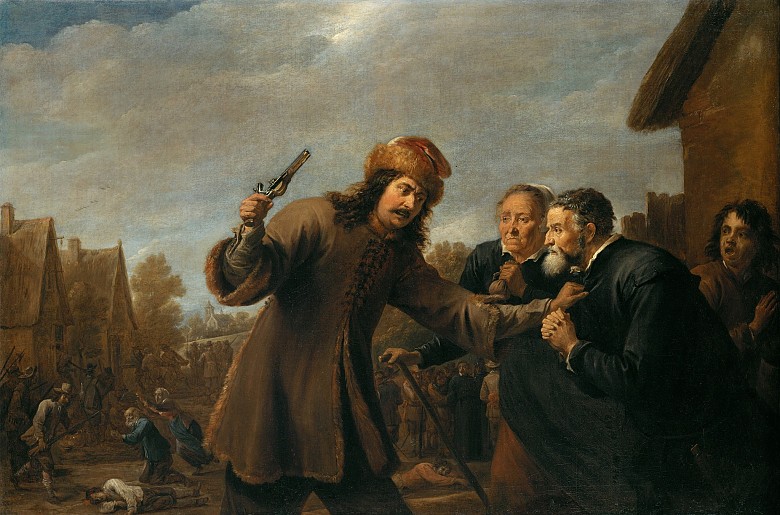Cindy's Renaissance Baroque Blog
Soldiers Attacking a Village by: David Teniers
1648 in Germany
Connection: This piece of art is a painting that represents The Thirty Year War. In this painting, there is a soldier raiding a village and harassing the villagers for supplies. You can see the girls' face are scared and unsure of what will happen, while the man looks angry, like he won't go down without a fight. The soldier looks uncertain, like he knows what he is doing is wrong, but it's his only way to survive. In the back, there are people trying to fight, as well as what looks like a dead man on the ground. In this piece, it's cloudy representing a dark time and the clothes that the villagers and soldier are wearing are dark too, giving the impression that it is a dark time in history. This was an oil painting, which was common. The detail is very good, but not as neat as some are, which is playing a role in the painting by making people think that maybe these people didn't have money and were struggling.
My Opinion: I wouldn't have this piece hanging in my house, it's not my style. However, I think it's a really good piece and gives off a lot of emotion and background to this time period.
Sources:
“Category:Paintings by David Teniers the Younger in the Kunsthistorisches Museum.” Wikimedia Commons, Mar. 2010, https://commons.wikimedia.org/wiki/File:Teniers_Soldaten_überfallen_ein_Dorf.jpg
Art, Philadelphia Museum of. “David Teniers's Theatrum Pictorium and the John G. Johnson Collection.” Philadelphia Museum of Art, 12 June 2010,

Hi Cindy,
ReplyDeleteI think the piece of art you chose for this weeks post was a painting that held a strong powerful message. I like how you used the connection of the painting and the cloudy sky to represent a dark time in history. I personally don't find this painting appealing because it shows the uncertain soldier going to hurt someone. I love art, I love sculptures and paintings that show happiness, or sadness that is directed from love. To me when I see this oil painting I see hate and fear. You don't mention this painting to be from the early, late, or Italian Renaissance except for the title of this post.
Great post Cindy! This painting did a fantastic job at capturing the chaos of The Thirty Year War. David used very few colors in this piece, but his extensive use of brown highlighted the dirt and grime of the ongoing war taking place. In addition, maybe David Teniers used more dull colors to extract the happy emotions out of the scene. I don't know if my computer's screen resolution is low, but it's almost as if the painting has been made to appear to be dirty or dusty.
ReplyDeleteHi Cindy,
ReplyDeleteI agree with you, this would not be a living room type of an art piece, however I could see it hanging in a trophy room, I guess it is also important about the setting in which the art is displayed.
I like the arty analysis and I can definitely see Baroque trademarks in this dark and abusive theme work. The relation to the thirty year war is also visible, therefore I think you did a good job, by selecting this work of art!
Great job !
Hello Cindy,
ReplyDeleteIt does reflect the thoughts and feelings of the time as war and conflict in general in Europe raged on continuously for 30 long and bleak years. The strong use of those dark and gritty colors helps convey the emotional turmoil people who had to deal with soldiers had to have been feeling. Not just about the people in focus but you can even see a struggle happening behind them. Well done on your post.